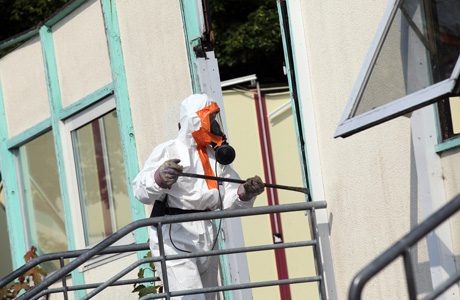
UKATA explains what to do when the best laid plans fail
In the light of several cases where asbestos has been incorrectly removed, or improperly disposed of, the UK Asbestos Training Association (UKATA) is reminding everyone of best practice on how to handle asbestos and while all steps should be taken to avoid accidents, what needs to be done in situations where they occur.
The best approach is of course to avoid situations where accidents can happen. When it comes to handling asbestos, a plan should be in place and for licenced work; properly trained individuals must be engaged to safely remove the substance. However, even with the best trained staff, accidents can and do occasionally happen. This mostly occurs in cases of accidental exposure of asbestos or when asbestos is not found in a survey. It is imperative in this situation that the staff involved make the necessary assessment and (if they are trained to do so), clean-up correctly to minimise the risk to themselves and others. Another key part of asbestos removal which is somewhat neglected is how to correctly remove and dispose of asbestos waste.
“Removal of asbestos from buildings is arguably only the first stage of the job. Knowing about how to clear up after an accident is nearly as important as knowing how to remove asbestos correctly in the first place” said Craig Evans, General Manager of UKATA. “When something has gone wrong in the removal process, there is the greatest risk of asbestos causing damage. It’s essential for asbestos professionals to be familiar with this. Furthermore, all employees should know the correct procedure for disposal of asbestos waste following successful removal.”
Should the unthinkable happen and asbestos be unwittingly disturbed, the first consideration is for the safety of those present. Those not licenced to work with asbestos should stop work immediately and evacuate the area.
If there is dust or debris on your clothes, if practicable, remove clothing or remove the top layer of clothing and place in a plastic bag. Put on a pair of disposable overalls if available, alternatively wipe down any contaminated clothing with wet wipes or a damp rag. In this instance it is essential to put on a respirator with a protection factor of at least twenty, which will minimise the risk of breathing in fibres. Afterwards, all clothing must be disposed of, and anyone affected should shower as soon as possible. The area where the asbestos found should then be cordoned off to prevent further exposure.
When it is confirmed that asbestos fibres have been released and workers exposed in an uncontrolled manner, the incident should be reported to the HSE under the Reporting of Injuries, Diseases and Dangerous Occurrences (RIDDOR) Regulations, as a dangerous occurrence. This would be classed as ‘accidental release of any substance that may damage health’. If you are concerned that you may have been exposed to asbestos in an incident you should consult your GP, and ask for a note to be made on your health record detailing the incident.
Disposal is relatively simple. There are clear industry guidelines which anyone working with and involved in the disposal of asbestos must be familiar with. Waste must be packed in UNapproved packaging with a Carriage of Dangerous Goods (CDG) hazard sign and asbestos code information visible. It should always be double wrapped. Any waste with more than 0.1% asbestos is classified as being ‘hazardous’. Most importantly, asbestos should always be disposed of at a licensed disposal site.
Of course, the best way to minimise the damage caused by accidents is by wearing protective equipment at all times – even when an asbestos survey has shown no asbestos present. Taking these steps, and correctly disposing of asbestos will minimise the damage that asbestos causes.
“If in doubt when it comes to asbestos, the best thing to do is leave it to the professionals,” said Craig. “By this, we mean someone who has received the correct and necessary training. Asbestos is much more dangerous than people give it credit for. It is no coincidence that Asbestos is known as the hidden killer and it is vital that it is treated with the seriousness it deserves.”
UKATA members provide training on asbestos safety, delivering the highest standard of asbestos training in the UK. For further information on UKATA, or to check out the very latest news and updates, visit www.ukata.org.uk
ENDS






